Colombia is a true paradise for fruit lovers, offering an astonishing variety of exotic tropical fruits that are rare or completely unknown in North America and Europe.
Whether you’re visiting or living in Colombia, you’ll find an abundance of flavorful, colorful fruits available year-round—many of them at very affordable prices.
While common fruits like apples, bananas, pineapples, and strawberries are easy to find, what truly sets Colombia apart is its wealth of native tropical varieties. From the Amazon to the Andes, the country’s biodiversity makes it one of the richest ecosystems on Earth.
In fact, Colombia is the second most biodiverse country in the world, home to nearly 10% of the planet’s species and over 56,000 registered plant species. This ecological richness, combined with its tropical climate and diverse geography—including coastlines, rainforests, mountains, and valleys—creates ideal conditions for a wide variety of fruit to thrive.
Across Colombian cities like Medellín, tropical fruits are widely accessible. Supermarkets such as Éxito and Jumbo offer a basic selection, but the best finds are often at local markets and neighborhood tiendas.
One of the top spots to explore is Plaza Minorista in Medellín, a bustling market where you can easily find over a dozen exotic fruits in a single visit—many of which are harvested locally and sold fresh.
In this guide, we’ll take you through 30 of the most exotic tropical fruits you can find in Colombia—how they taste, where to find them, and why they’re worth trying.

Colombian Fruits #1. Arazá
Taxonomic Name: Eugenia stipitata
Arazá is yellow fruit about softball size and it has several large seeds. This fruit is very sour. So, it typically is consumed as juice with sugar added or in smoothies with sweet fruits like bananas added. I haven’t seen this fruit for sale very often. But you can find it sold as an exotic jam and I have seen it used in ice cream as well.
Arazá is a native fruit tree found in the Amazon in Brazil, Colombia and Ecuador. Arazá has a high vitamin C content, which is double the amount of an average orange. It also has a high level of protein and potassium, which is a rarity for fruits.

Colombian Fruits #2. Badea (a.k.a. Giant Granadilla)
Taxonomic Name: Passiflora quadrangularis
Badea is the largest fruit in the passionfruit family. The size ranges from 10-30 cm long and 8-16 cm wide. This green fruit has a white pulpy flesh inside, which has a bit of sweetness to it. But it’s also pretty bland. So, this fruit is normally not eaten alone and is mixed with other fruits in desert or is cooked or processed and eaten in other forms.
The pulp from the Badea is reportedly used as a mild sedative. It also is nutritious with high levels of calcium, phosphorous and niacin.

Colombian Fruits #3. Banana Bocadillo (a.k.a. Lady Finger Bananas)
Taxonomic Name: Musa asuminata
Banana Bocadillos, also known as lady finger bananas are smaller than regular Cavendish bananas with thinner skin. Bocadillos taste sweeter than common bananas. Also, they tend to oxidize slower and will keep on the counter for up to a week.
Lady finger bananas are high in potassium and fiber. They are also rich in vitamins C and B5, with lesser quantities of vitamins A, E and K. In addition, they are also high in minerals such as manganese, magnesium, calcium and zinc.

Colombian Fruits #4. Borojó
Taxonomic Name: Alibertia patinoi
Borojó is a dark round fruit that has a reputation in Colombia as being a natural Viagra. This fruit is grown primarily in the Chocó region of Colombia. It’s green when unripe but turns brown when mature and falls to the ground for easy collection.
When I tried this fruit, I found it somewhat bitter but pleasant. In juice form, it normally has honey added. It’s also sold in jam form.
This fruit is a natural source of energy due to a high level of B vitamins. In addition, Borojó in an excellent source of protein, vitamin C, calcium and iron plus it’s also high in fiber. Also, it is high in phosphorus and protein, a rarity for fruit.

Colombian Fruits #5. Caimito
Taxonomic Name: Chrysophyllum cainito
I haven’t seen this fruit sold in Medellín but found it in Cartagena. It’s a dark purple or green fruit where seeds form a star when it is cut. Caimitos reportedly will not ripen after they are picked, so they must be picked from trees when they are mature. Make sure to look for caimitos that have started to soften to make sure they are mature.
This fruit is also known as a star apple. The filling is white with a mild grape flavor that I thought was tasty. This fruit contains moderate amounts of calcium, phosphorus and ascorbic Acid. And it’s considered a good source of anti-oxidants.
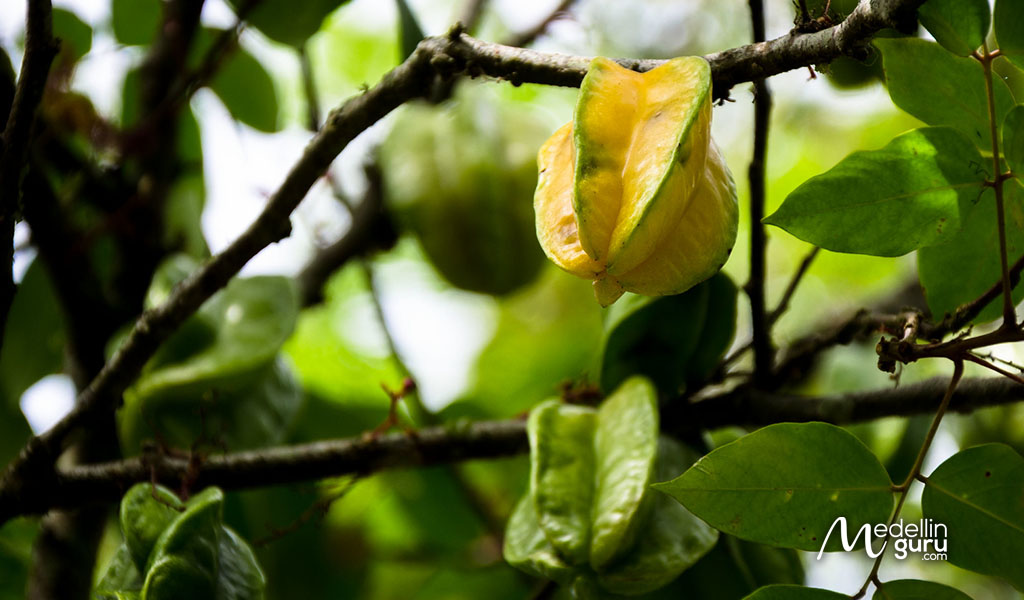
Colombian Fruits #6. Carambolo (a.k.a. Starfruit)
Taxonomic Name: Averrhoa carambola
Carambolo is also known as starfruit, which got its name from the five-pointed star shape when cut across the middle. Carambolo is a small, bushy evergreen tree that grows well under hot, humid, tropical conditions.
To me, the flavor is kind of a mix of plums, pineapples and lemons. Others say the flavor is a mix of apples and grapes. The flesh of this fruit is juicy and crunchy, and it may be eaten with the skin and seeds. Carambolo is low in calories but high in fiber and vitamin C.
Warning, don’t eat carambolo if you have kidney problems. This fruit contains a neurotoxin that healthy kidneys can filter out, but damaged kidneys are unable to do so.

Colombian Fruits #7. Cherimoya (a.k.a. Sugar Apple)
Taxonomic Name: Annona cherimola
The cherimoya, also known as the sugar apple, is irregularly oval or heart shaped. Ripe cherimoyas have a sweet, fragrant aroma. A cherimoya has a creamy pulp that can been eaten straight from the fruit. In my experience, it has the consistency of ice cream. The large black seeds and skin are inedible.
This fruit is also used in smoothies and pie fillings. A single cherimoya provides 7 grams of fiber and is also high in vitamin C and potassium.
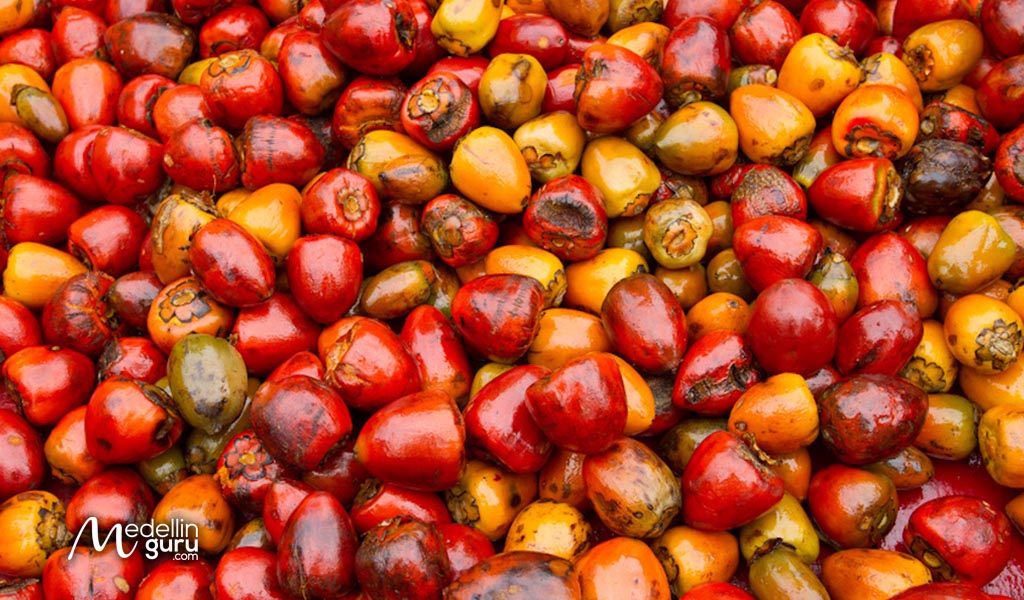
Colombian Fruits #8. Chontaduro
Taxonomic Name: Bactris gasipaes
Chontaduro is a fruit that grows in a cluster on a palm tree that is common from the Pacific region of Colombia. These fruits have very hard flesh, so they are normally cooked for 3-5 hours. This fruit is tasty after being cooked and to me tastes like a sweet potato. I have seen it sold with salt and honey spread on top.
You can find chontaduro in Medellín in El Centro and also in Plaza Minorista. This fruit has as much protein as eggs and is also rich in vitamin A, zinc, cooper, calcium, iron and beta-carotene. It also has high levels of omega-3 and omega-6 polyunsaturated fatty acids.

Colombian Fruits #9. Ciruela
Taxonomic Name: Spondius purpurea
Ciruelas are also known as Spanish plums. It has a sweet and juicy flavorful skin and flesh. In addition, it has a big seed inside. Don’t eat the seed as it’s toxic. Ciruelas are like plums but taste to me kind of like a mix of a tomato and apple. They are eaten fresh, squeezed for juice or preserved.
This fruit is rich in in vitamin C and serves as an antioxidant. Also, Ciruelas are boiled and used as an antiseptic for preventing infection of wounds.

Colombian Fruits #10. Corozo
Taxonomic Name: Bactris guineensis
Corozo is a small red fruit that grows on palm trees. I have only seen this fruit along the coast. This acidic fruit is collected and boiled in water sweetened with panela to obtain burgundy colored syrup. This syrup is used to make a tasty juice as well as jam, jelly and ice cream.
In my experience, it tastes somewhat like cranberry. In addition, the syrup can be fermented to make a wine. Sucre even holds a festival in honor of corozo.

Colombian Fruits #11. Curuba
Taxonomic Name: Passiflora tarminania
Curuba is a fruit with a yellow pulp and black seeds that is sometimes called the “banana passionfruit”. Furthermore, Curuba is usually eaten raw and is better in my experience when mixed with some sugar and milk. It has a high pectin content so this fruit is used in jams and also as a pie filling.
In addition, Curuba is full of proanthocyanidins, which are powerful antioxidants, and this fruit is reportedly is being used by some to prevent damage caused by pollution.
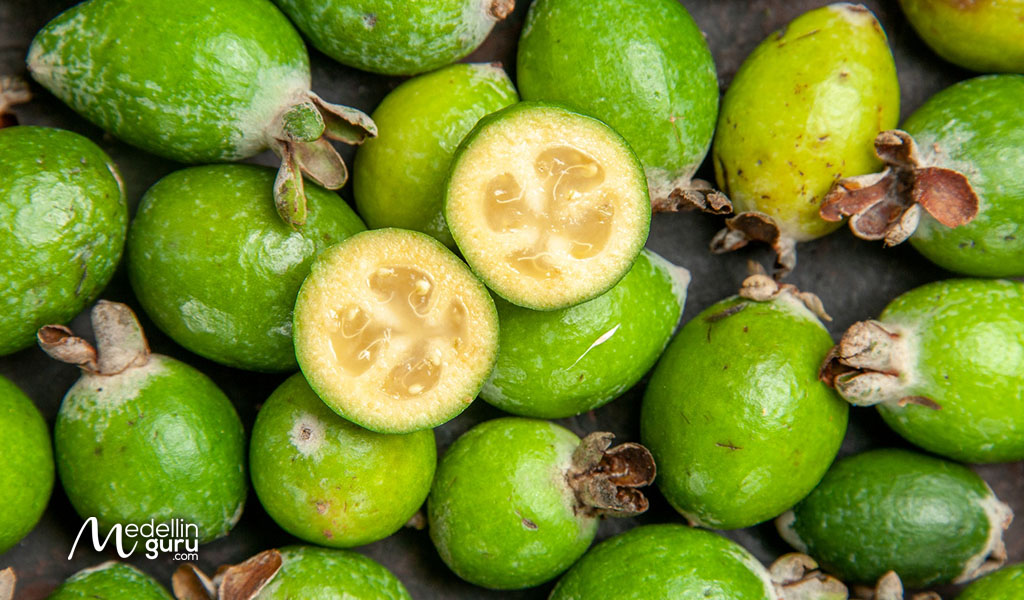
Colombian Fruits #12. Feijoa
Taxonomic Name: Acca sellowiana
The feijoa is an egg-shaped, lime-green fruit that is sometimes known as the “pineapple guava”. The skin sometimes has a red or orange blush. And the texture of the skin ranges from smooth to rough. The creamy white flesh inside is somewhat sweet and tastes kind of like a combination of pineapple and strawberry with possibly some spearmint thrown in.
Feijoas are low in calories and are also a rich source of fiber. 100 grams of fruit is only about 55 calories but 6.5 grams of dietary fiber. In addition, they are a good source of vitamin C. Feijoas also contain small portions of B-complex vitamins and vitamin E and K as well as minerals such as calcium and magnesium.
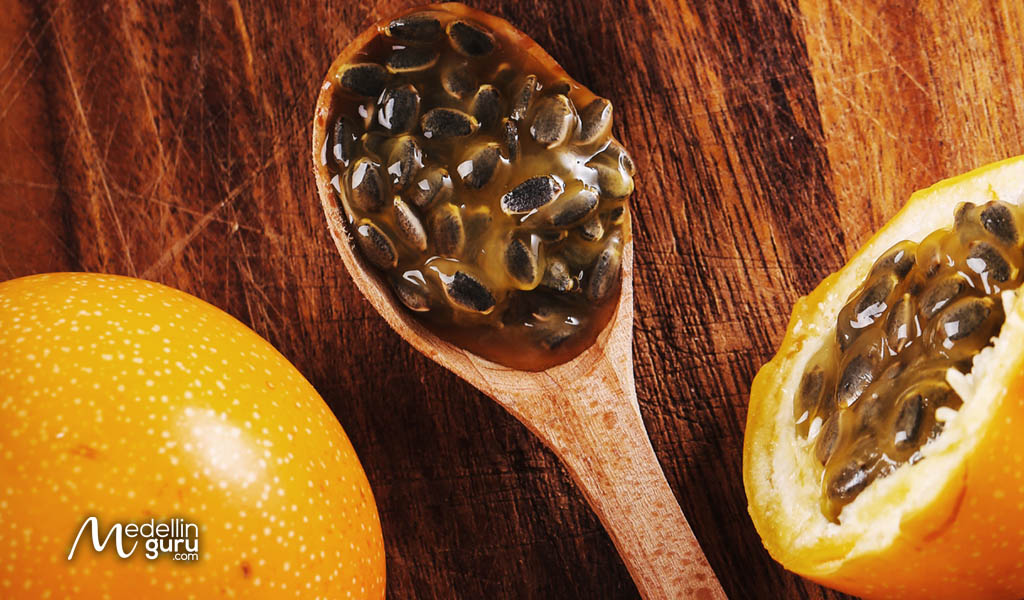
Colombian Fruits #13. Granadilla
Taxonomic Name: Passiflora ligularis
Granadilla is a round fruit with a hard and shiny orange skin. It is easy to find, as it’s a popular fruit in Colombia. This fruit is considered a cousin to maracuyá. Both have a similar texture and color. But the granadilla is sweeter compared to the acidic maracuyá.
The granadilla fruit contains a jelly-like pulp with seeds that are edible. This fruit can be eaten fresh and to me tastes like a mild maracuyá. The tart and sweet pulp is also used to make juice, jam, ice cream and a number of desserts.
Granadilla is a good source of dietary fiber, vitamin C and vitamin A. In addition, it’s a good source of potassium, copper, iron, magnesium and phosphorus.

Colombian Fruits #14. Guama (or Guaba)
Taxonomic Name: Inga edulis
Guama is a delicious fruit that is also known as the ice cream bean. It can be more difficult to find in my experience. I’ve occasionally seen guama being sold in El Centro in Medellín. This is a unique and very unusual pod fruit.
The dark green pods can be a long as your forearm. Inside the pods are found what looks like white cotton candy wrapped around seeds. The seeds are inedible unless cooked. And the white pulp is stretchy and a bit sticky. It has the sweetness of a banana but a taste that is quite different.
Guama is a good source of dietary fiber and anti-oxidants. Furthermore, reportedly this fruit is anti-inflammatory and can help lower blood pressure.
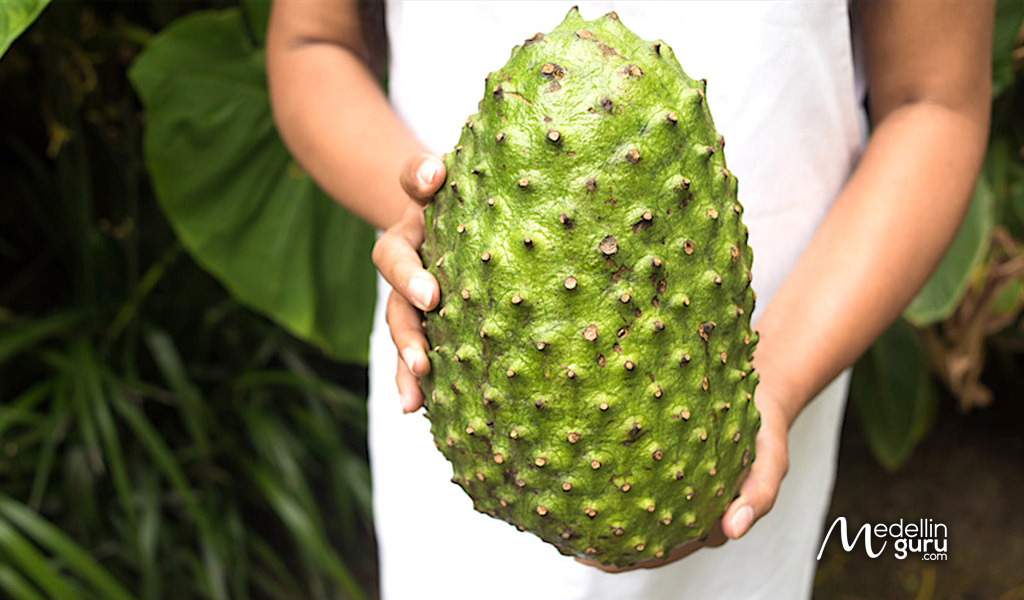
Colombian Fruits #15. Guanabana
Taxonomic Name: Annona muricata
Guanabana is an exotic-looking, large green spiky fruit. This sizable fruit can be sizable and weigh up to nine pounds. The juicy, white flesh of this fruit tastes to me kind of like a combination of pineapple and strawberry while also being somewhat creamy. But I didn’t really like the texture, which was kind of slimy. In addition, this fruit is frequently used in juices, smoothies and ice cream.
Guanabana is a good source of vitamin C, B vitamins, calcium, phosphorous and even some iron. Furthermore, guanabana is popular for its supposed cancer-fighting properties, which haven’t been proven scientifically.

Colombian Fruits #16. Guava (Guayaba)
Taxonomic Name: Psidium guajava
Guava is a round or pear-shaped fruit that is green in color. It’s one of my favorite fruits found in Colombia. They are typically soft, sweet and fragrant when ripe. Inside is a pink interior that has tiny seeds that are also edible. Guava can be eaten raw or consumed as juice, jams and jellies. Also, guava is the base for bocadillo, the gelatinous bricks sold in Colombia.
Guava is a good source of dietary fiber, vitamin A, vitamin C, vitamin B-6, folate, thiamine and riboflavin. In addition, it has calcium, phosphorus, iron, magnesium and potassium.
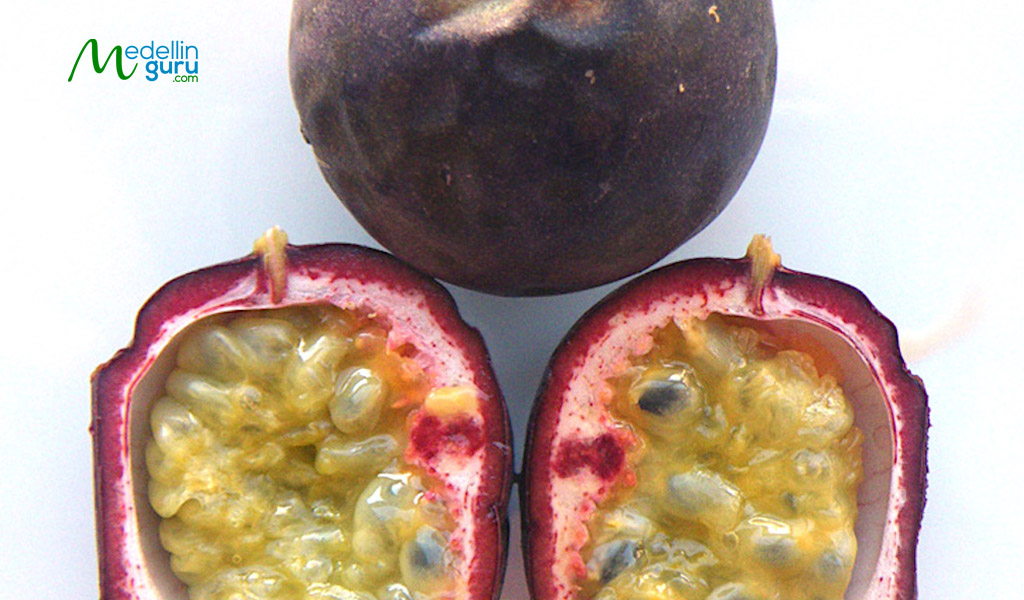
Colombian Fruits #17. Gulupa
Taxonomic Name: Passiflora edulis
The gulupa belongs in the passionfruits family. The shell of the fruit is a smooth, thick and dark purple. You can tell when a gulupa is ripe as the purple skin becomes wrinkled. The yellow and juicy pulp inside covers dark seeds that are edible.
A gulupa has a pretty unique flavor, mildly sweet and also sour. If you cut a gulupa in half you can scoop out the pulp with a spoon to eat. But it’s normally used in juices and smoothies. In addition, gulupa is an excellent source of vitamin C and is believed to also help control tension.
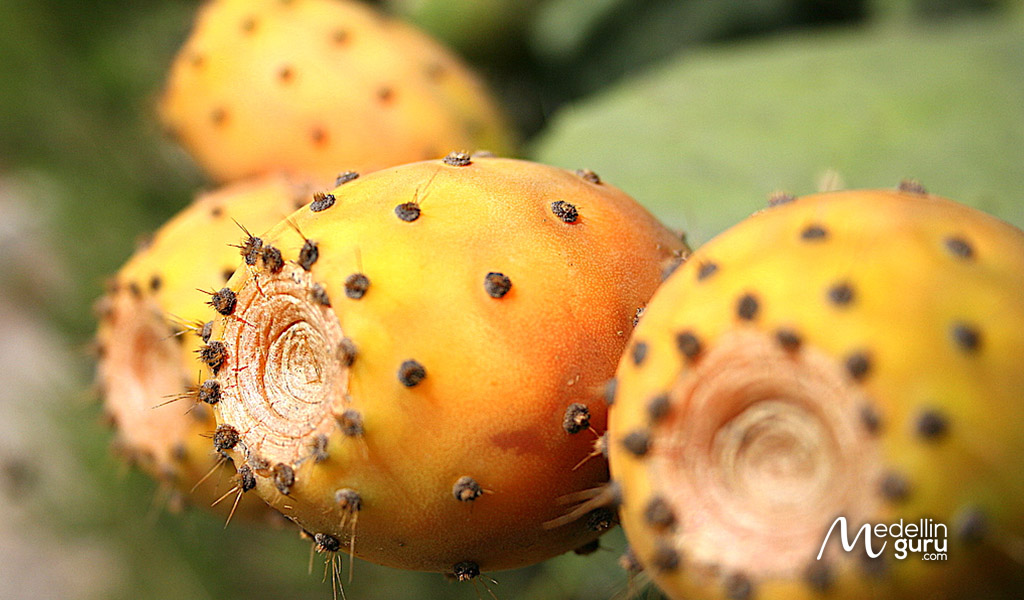
Colombian Fruits #18. Higo
Taxonomic Name: Opuntia ficus-indica
Higo is available in both reddish-orange and green varieties. This fruit looks like a cactus and it does actually grow on a cactus. So, be careful of the thorns. The flesh inside is a deep-orange color with small hard seeds. To me the flavor of the higo is similar to a non-sour kiwi.
Higo is a good source of dietary fiber as well as vitamin A and several minerals including copper, iron and magnesium.
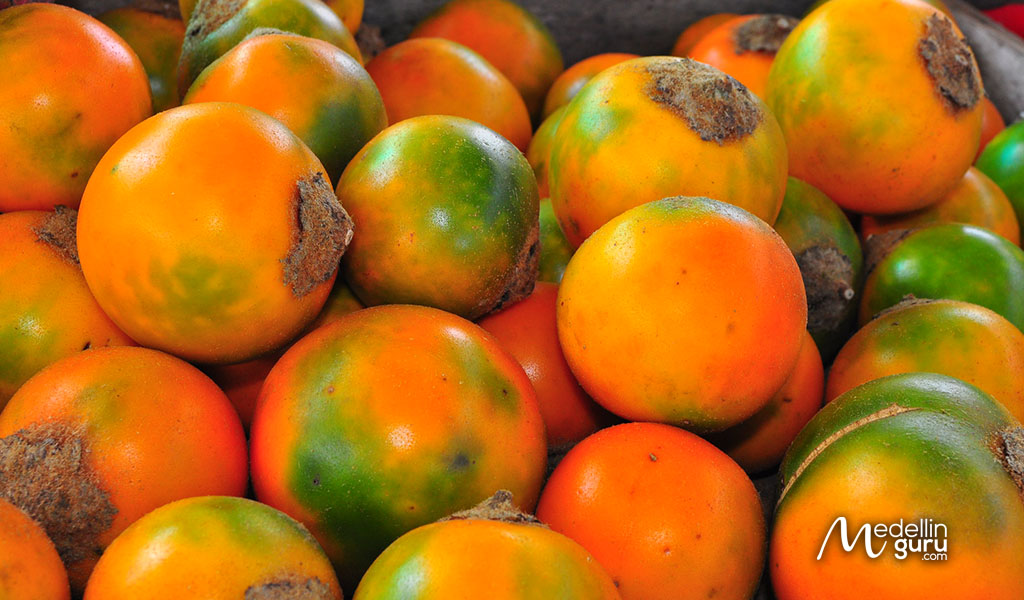
Colombian Fruits #19. Lulo
Taxonomic Name: Solanum quitoense
Lulo looks like an orange from the outside and more like a translucent tomato on the inside. The fruit can be eaten raw or cooked. But Lulo for most people is too tart to eat alone. So, it’s most common use is for juices. Lulos are also used in jams, jellies and ice cream.
Lulo fruit has high levels of vitamin C, vitamin A, niacin, riboflavin and thiamine. It also has calcium, iron, phosphorous and dietary fiber.

Colombian Fruits #20. Mangosteen
Taxonomic Name: Garcinia mangostana
Mangosteen is a fruit that grows on an evergreen tree. In Southeast Asia, the mangosteen is known as the “fruit of the gods”. The hard rind of the mangosteen is reddish-purple when ripe. Inside is a white flesh with a milk-like juice.
The taste of the mangosteen to me is a sweet and tangy combination that is pretty unique. Others have said it has a taste that is a combination of several other fruits like strawberries, kiwis, plums, peaches and mangos. It’s one of my favorite fruits in Colombia.
Mangosteen is a good source of vitamin C and vitamin A. In addition, they are low in calories with only 63 calories per 100 grams of fruit. Furthermore, different parts of the mangosteen and plant are reportedly used in the treatment of various diseases and disorders, including cancer, cardiovascular diseases, tuberculosis and Alzheimer’s disease.

Colombian Fruits #21. Mamoncillo (a.k.a. Spanish Lime)
Taxonomic Name: Melicocus bijugatus
Mamoncillo is a small green fruit that grow on branches. And they are a little larger than olives. They are also known as chenet, genipe, limoncillo, mamón, Spanish lime, and many other names.
Mamoncillo have a thin skin that is hard and rigid that can be cracked with your teeth. Inside is an orange and yellowish fruit that is creamy and juicy similar to a lychee. One can be eaten fresh after peeling the skin. The taste is normally tangy and a bit sweet. Because of the small amount of edible fruit, it can be boiled and used in cold drinks. It is also used in juices and jam.
Mamoncillo is a good source of vitamins A and C, as well as fiber, calcium and phosphorus. But be careful, make sure that mamoncillo fruits are ripe, as raw ones may contain some toxins.
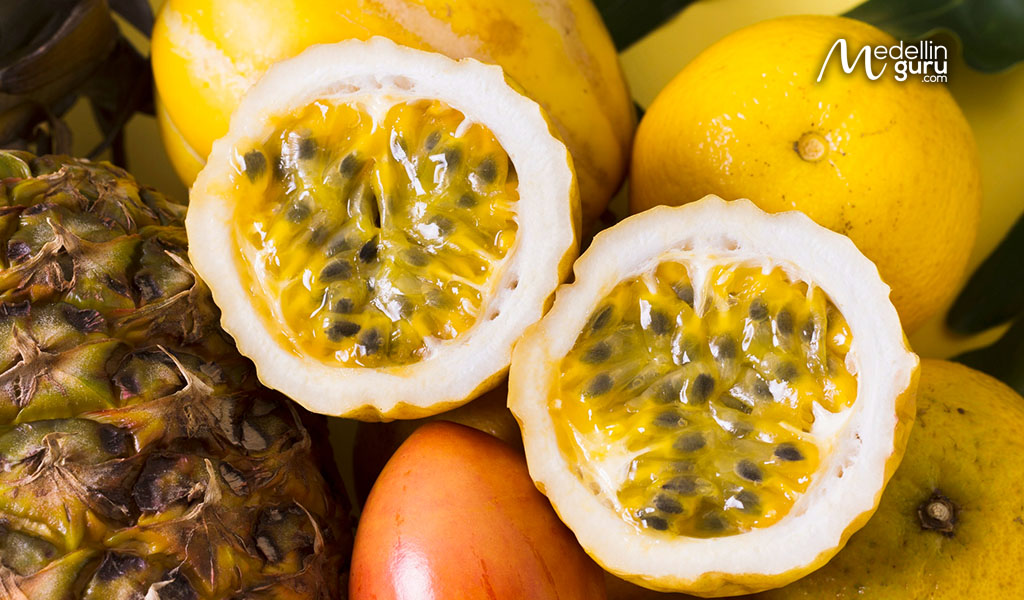
Colombian Fruits #22. Maracuyá
Taxonomic Name: Passiflora edulis
Maracuyá is also known as passionfruit. This fruit has a thick yellow skin. The pulp of the maracuyá is extremely tart when eaten alone. So, many that eat it this fruit raw mix it with sugar. However, maracuyá is mainly used to make a delicious juice.
Maracuyá is a good source of dietary fiber, vitamin A, vitamin B, riboflavin and niacin, as well as copper, iron, magnesium phosphorus and potassium.
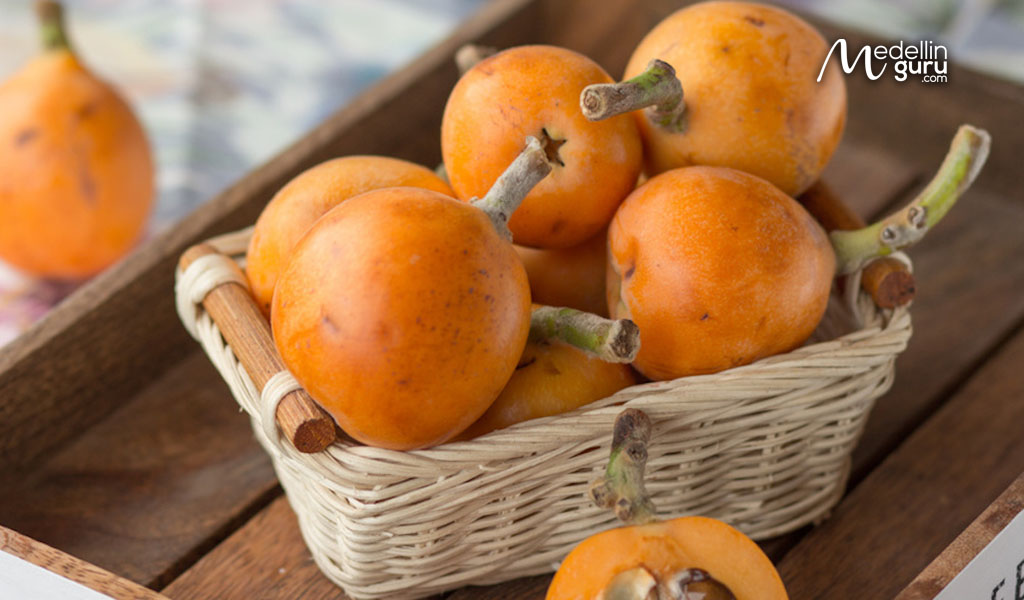
Colombian Fruits #23. Nispero (a.ka. Loquat)
Taxonomic Name: Eriobotrya japonica
Nispero is a yellow to orange fruit and ripe fruits have a soft texture. Inside the flesh is white or golden yellow. Also, it will typically have up to five seeds that are not edible. Nisperos to me have a pretty similar taste to apples, both tart and sweet. But nisperos have a more soft and juicy texture.
Nisperos are low in calories but are rich in dietary fiber, pectin and vitamin A. Furthermore, the fruit is a good source of calcium, copper, iron and other minerals. In addition, the nispero has been called a super-fruit with claims that it has cancer fighting properties and also helps maintain a healthy blood pressure.

Colombian Fruits #24. Papaya
Taxonomic Name: Carica papaya
Papayas are pear-shaped or spherical fruits that can be as long as 20 inches and weigh up to 20 pounds but the ones typical found in markets normally are about one pound. The flesh of a papaya is a rich orange color. Inside the inner cavity of a papaya are found seeds that are edible but taste somewhat bitter. Once you get past the smell of papayas, they tend to be tender and sweet.
In my experience, people seem to either love the flavor of papaya or hate it. My Colombia wife loves eating cubed papaya but I don’t really care for the fruit.
Papayas are rich sources of vitamin C (more than oranges), vitamin A and B-complex vitamins. In addition, they are a source of copper, magnesium and potassium. Furthermore, the papaya is low in calories and has a good amount of dietary fiber.

Colombian Fruits #25. Papayuela
Taxonomic Name: Vasconcellea pubescens
Papayuela is a dark yellow or orange fruit when ripe. The flesh of a papayuela is similar to the papaya, but not as strong. Inside the pulp is a kind of jelly-like with seeds that look almost like tiny pine cones. This fruit is commonly cooked into candies or preserves. But it can also be eaten fresh. To me, the flavor of the papayuela is kind of a mix of an orange, pineapple and strawberry.
Papayuela is a good source of dietary fiber, vitamin C and vitamin A. In addition, it’s a source of copper, magnesium and potassium.

Colombian Fruits #26. Piñuela
Taxonomic Name: Bromelia pinguin
Piñuela is a small shallot-shaped fruit. To eat one, it is peeled like a banana. Inside is a white floss with seeds that tastes fairly tart in my experience and it is used in juices. The piñuela fruit is reportedly more common in in the Cauca Department in Colombia, near the Pacific coast. I have only seen this fruit a few times in Medellín.
Piñuela is a good source of dietary fiber, vitamin C, calcium, magnesium and zinc.

Colombian Fruits #27. Pitaya or Pitahaya
Taxonomic Name: Pitaya stenocereus
Pitaya is also known as dragon fruit due to its thick yellow scales. Inside the white flesh is flecked with an abundance of tiny black seeds that are edible. The flavor is mild, which to me tastes like a combination of a kiwi and a pear. I typically cut a pitaya in half and scoop out the flesh with a spoon.
Pitaya are low in calories but rich in nutrients. They contain vitamin C, polyunsaturated fatty acids, and several B vitamins, as well as carotene and protein. In addition, calcium, iron and phosphorus is present.
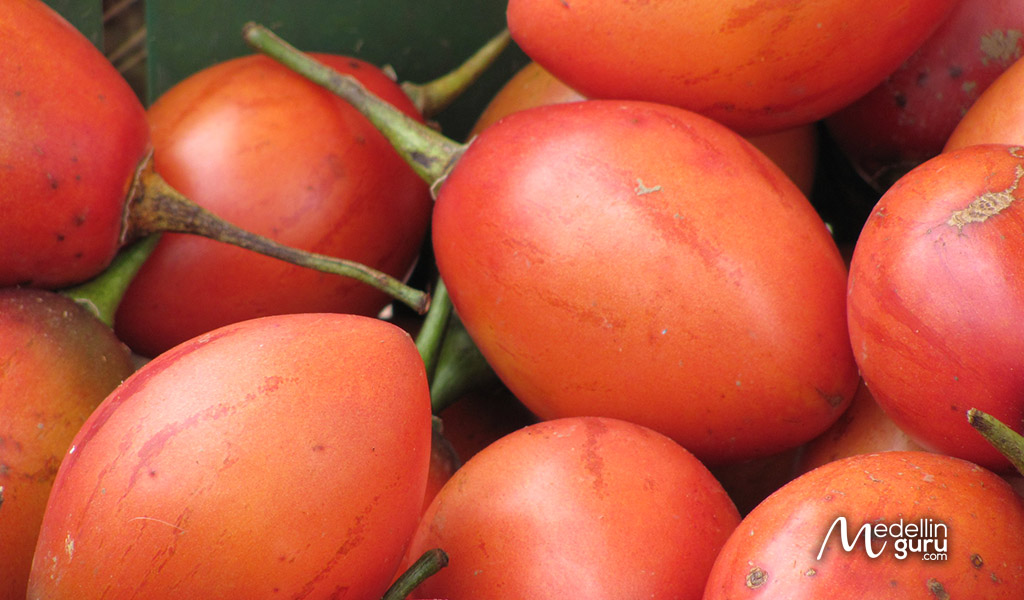
Colombian Fruits #28. Tomate de Arbol
Taxonomic Name: Solanum betaceum
Tomate de Arbol is a red or orange colored egg-shaped fruit. Inside the flesh is orange and juicy with numerous small seeds. The flavor is a bit sweet and is also somewhat tart. It can be eaten alone or sprinkled with salt. This fruit is mainly used to make juice. And this juice is popular with menú del dia offerings at many local restaurants in Colombia.
Tomate de Arbol is a very low-calorie food with only 31 calories per 100 grams of fruit. It is a good source of vitamin C, vitamin A, vitamin E. It’s also a source of copper, iron, magnesium and phosphorus.

Colombian Fruits #29. Uchuva
Taxonomic Name: Physalis peruviana
Uchuva are small, round, bright yellow fruits that are encased in delicate paper-like husk. They are small sized like a cherry and have a similar texture. The flavor is tart while also being sweet. In Colombia, they seem to like selling uchuva with honey or chocolate. Uchuva are also used in pies, puddings, ice cream and eaten fresh in fruit salads.
Uchuva has more dietary fiber than prunes, is a good source of B12 and is a good source of phosphorous and vitamins A and C. Uchuva are ripe when the outer husk is dry and comes off easy. Be careful as unripe uchuva fruits are reportedly poisonous. But I’ve never seen unripe uchuva being sold.
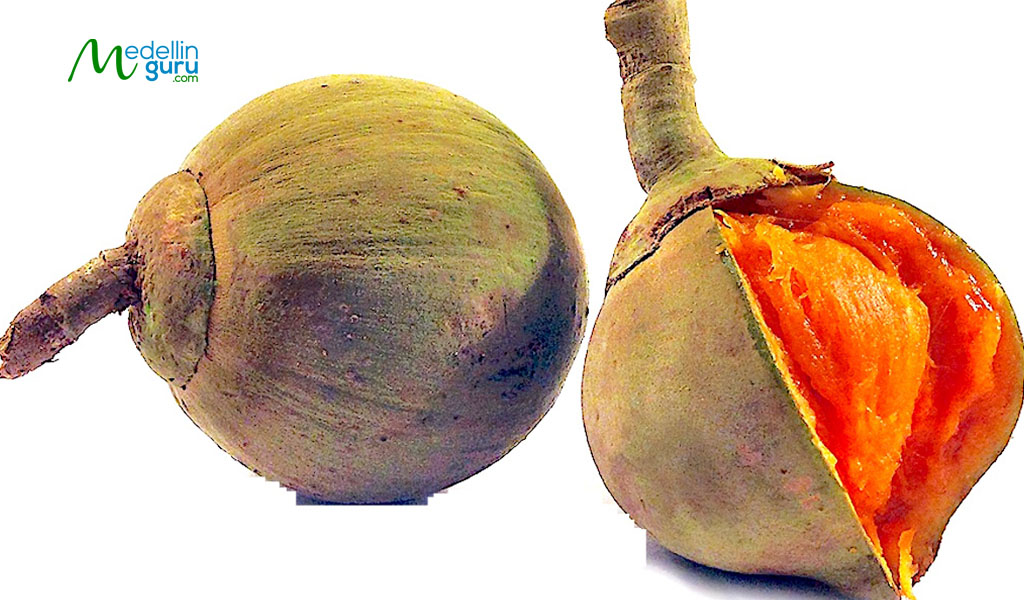
Colombian Fruits #30. Zapote
Taxonomic Name: Quararibea cordata
Zapote is a roundish brown fruit with a rough texture. Inside the flesh is dark orange and creamy with two large seeds. This fruit can be eaten raw. However, I didn’t like the strong flavor of the zapote when I tried one.
In addition, it is commonly used in smoothies, milk shakes and ice cream as well as jams and jellies.
Zapote is a good source for dietary fiber, vitamin C, vitamin B6, vitamin E, riboflavin, niacin, manganese and potassium.
Medellin Guru Insurance Service
The insurance agency we partnered with has helped 1.893 Medellin Guru readers.
Medellin Guru’s Guide to Colombian Food and Drinks
On the Medellin Guru website, we have six articles covering Colombian food and drinks:
- 16 Traditional Colombian Food Dishes You Must Try in Colombia
- 16 Colombian Street Food Options You Really Must Try
- 17 Popular Colombian Desserts You Must Try While in Colombia
- 30 Exotic Tropical Fruits of Colombia a Fruit Lovers Paradise
- 13 Traditional Colombian Drinks to Try When You Visit
- 12 Popular Colombian Soups to Try When You Visit Colombia
The Bottom Line: The Bottom Line: Discover Colombia’s Tropical Fruit Diversity
Colombia is considered one of the most fruit-diverse countries in the world. According to the Alexander von Humboldt Biological Resources Research Institute, the country is home to at least 400 different types of fruits and seeds—a testament to its rich biodiversity and varied geography.
While some of these exotic fruits can be found in supermarkets across cities like Medellín, the best way to explore the full spectrum of Colombian tropical fruits is by visiting traditional markets such as Plaza Minorista. There, it’s not uncommon to find 15 to 20 of the 30 fruits featured in this guide—fresh, seasonal, and often sold at lower prices than in large retail chains.
Colombia’s fruit scene is a sensory adventure waiting to happen. Whether you’re a curious traveler, a health-conscious foodie, or simply looking to expand your palate, these exotic fruits offer a delicious and affordable way to connect with the country’s natural abundance.
How many of these fruits have you tried?
Start checking them off your list—and don’t be surprised if a few of them become your new favorites.
Medellin Guru Social media
Be part of our community. Find out about news, participate in events and enjoy the best of the city.


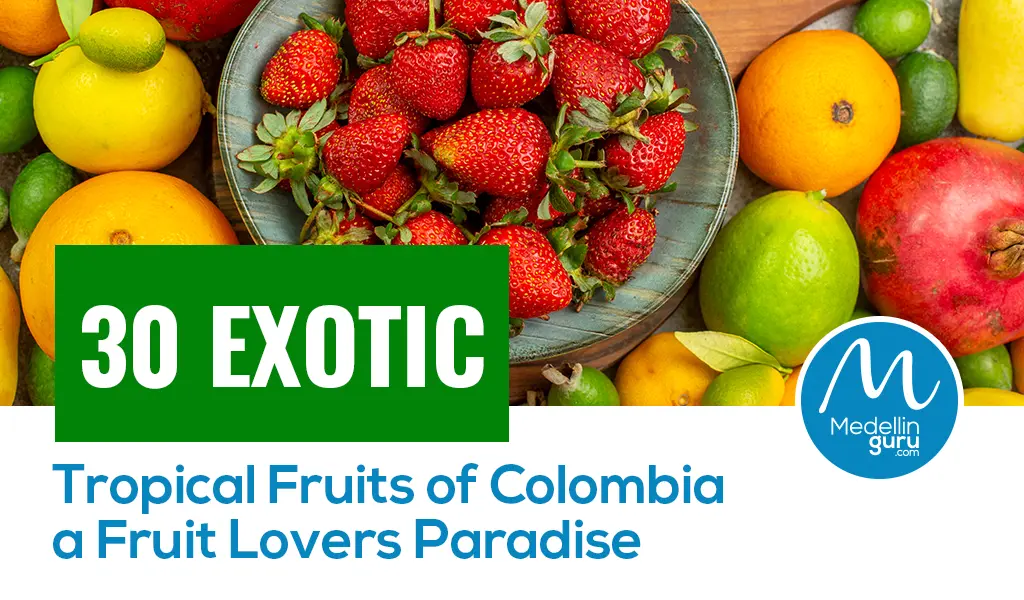
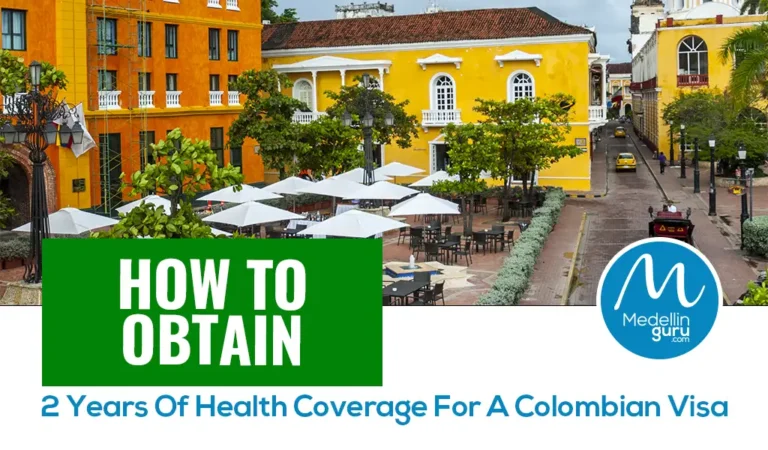






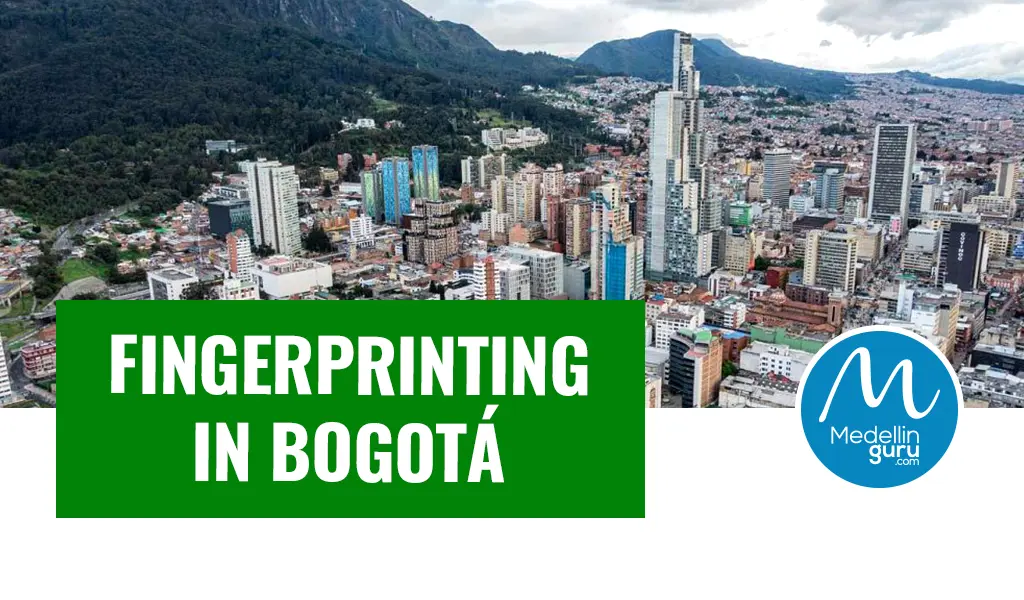

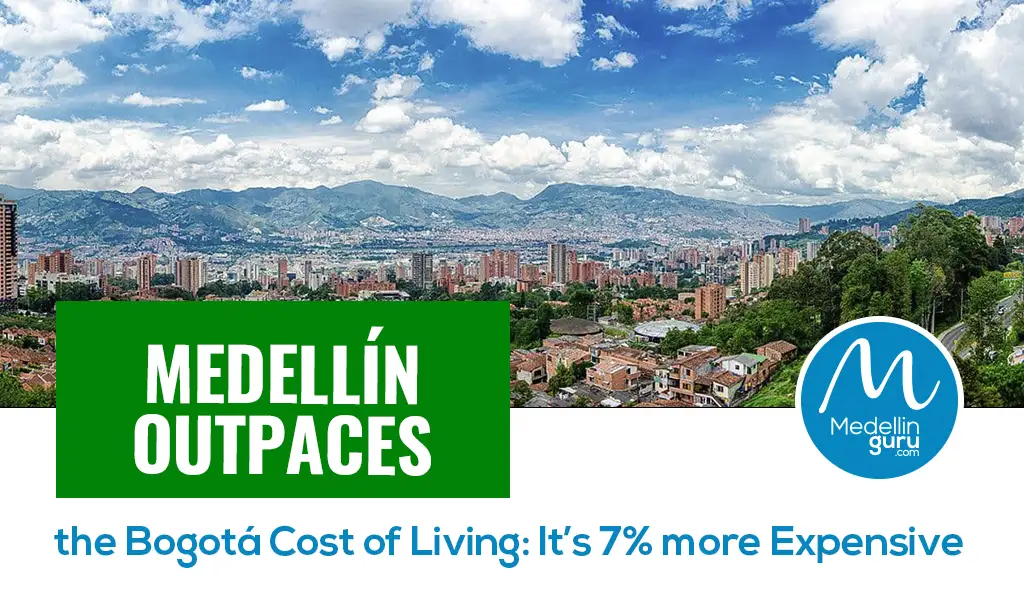





















29 thoughts on “30 Exotic Tropical Fruits of Colombia: A Fruit Lover’s Paradise – 2025 Updated List”
A retired gringo, non smoker in great shape looking to live in M. looks like it rains a little almost every day. Don’t like too much noise, smokers, drinkers, traffic, love
nature, crazy for tropical fruits as I used to live in Escazu outside of San Jose in Costa Rica and lived on TF for months, in your great article on C fruits I was disappointed not to find the white small sopote, which must grow somewhere in C, right? I was for many years one of the most successful real estate experts in
America, specializing in acreage, raw land, which is called hectares in C, right? I plan to open up the #1 real estate investment firm in C utilizing the finest lawyer
who has the essential experience in property and the best notary as I understand these 2 ingredients are required to close these types of transactions. I would need a translator as I speak little spanish, and in the beginning someone with a good car who is bilingual and doesn’t smoke. I love senoritas but only if they have good teeth, dress well, don’t smoke or drink, and take care of themselves both physically and mentally, I am very particular and don’t date here in America as my cup of tea is not bars and loud rock concerts. Do watermelons grow on the atlantic coasts and are they brought into M, as I love good W and I hate coconuts but love coconut water sliced from the big coconut, I drank that everyday in San Jose. I travel to Miami for Miami Heat and University of Miami basketball games as I was a basketball player and tennis player and travel to Paris for the French Open at Roland Garros and take the bullet train to Lyon for
the best foods in all of Europe. I would need a great one bedroom condo with all amenities plus good security, for rent in the beginning and if I liked M I would
invest myself as my source of income would be thru representing sellers of property. Can you perhaps assist or introduce me to get started as I would be making my first trip to M in december. Have you heard of the Sugarloaf Pineapples? they come from Hawaii on the island of Kauai and are black and white inside and
are the sweetest fruits in the world, absolutely zero acid and taste like heaven. I’d love to own and start to grow the largest Sugarloaf Pin Farm, the people in C
would go crazy for them, and give them pride in having the very best fruit in the world in their country. Lawyer, Notary, Driver who has top auto, very clean, speaks both E and S and doesn’t smoke, if he had one cigarette a week ago in secret the moment he spoke I could tell he was a smoker, see if you can help me
and I’d have some fresh Alaskan King Scallops to grill for you in my condo in M with the best Colombian coffee and later on anonas which are the sweetest
cheramoyas for dessert. Wow, all I would need after that is Jaylo to rest her head on my shoulders.
Hi Richard, thanks for your comment. We love it when our readers leave us suggestions of what they would like to see in our next articles, so we will take what you tell us into account! Also, regarding the services you are looking for, we have some options for you in our directory: JJMdeTours is the best ally regarding transportation, they are reliable and punctual, here we leave you the link: https://medellinguru.com/directory/jjmdetours/ To create your company in Colombia, expatgroup.co can help you in the different processes because they have bilingual and trained personnel who can advise you, here we leave you the link: https://medellinguru.com/directory/expatgroup/ And finally, to find your ideal home to be in Medellín, in this link you will find great options: https://medellinguru.com/business/real-estate/
Wow, nice article about the fruits of Colombia
Thanks for this information about the immense number of fruits of Colombia. It is a fruit lovers paradise.
This is a great guide to the fruits of Colombia, thanks for putting this together.
Dear Jeff :. For the last four years I been looking for frutas endemicas and frutas naturalized in Colombia. I almost ready to published aBook about Trilobites with different fruits Andalusia the Health Benefits of each fruit this Drawings are all different and I proud of discovered ( 184 ) fruits. Most of them are possible to found in Colombia . the flavor and sized of the Colombian Fruits is absolutely unique Some examples as a 50 or more inches Papayas, a Mango of ( 4 or more pounds ) The tremendous flavor of a Lime or the Maran’on fruit absolutely on and on and on.???.
we will be flying in on Nov 27th for a two-week stay. My wife’s cousin moved to Medellin several years ago from Waco, Texas and has been trying to get us to visit. After reading your post we are excited to be coming.
Hey Jeff I used to live in South East Asia so Mangosteens are one of my favorites, where can I find those in Medellin?
You can find mangosteens at Plaza Minorista – https://medellinguru.com/plaza-minorista/ and I have occasionally seen them at big grocery stores in Medellín.
Does Dorian Grow in Colombia?
It is Durian and not found in Colombia that I am aware of. Durian is from China and Southeast Asian countries.
Hi Jeff!! I’m from Colombia and currently I’m living in Beijing, so your article helps me a lot to show the host family that has received me some exotic and very delicious tropical fruits of my country !! Thank you very much !! Greetings from China!!
Thanks again for your magnificent information about our immense galore of fruits because in Colombia you encounter not only endemics fruits but also fruits from all over the world it is without exaggeration the real tropical paradise. Thanks for the fantastic essay about our beautiful country.
Hello Jeff, thanks for putting this list together. Nobody in Min Agricultura or Asofruhocol could provide me something similar. Don’t you by chance have an even larger list? I suppose this could grow into the hundreds…
Thanks!
Thanks for the terrific guide
Thanks for the terrific post
hi! I am trying to identify a fruit we recently ate, in Panama. You have it pictures in the main photo, but not listed. It’s in the bottom right hand side of the photo to the immediate left of the Mangos and under the Papaya. I’d love any help you can offer with identifying this fruit. Thanks!
Hi Dashaina, that fruit is the Zapote, the last fruit in this article.
Hello Mr Jeff.
In Antioquía and Medellín the minibananas (you called Lady bananas) are called MURRAPOS or MANZANITOS. And the Cherimoya is better call CHIRIMOYA.
Other fruits.
ALGARROBA
COROZO (coquito)
CHACHAFRUTO
NARANJA AGRIA
GUAYABA PERA
GUAYABA MANZANA
POMARROSA
MADROÑO
AMOLAO
TORONJA
ZAPOTE DE CARNE (ZAPOTE COSTEÑO)
TAMARINDO
JABUTICABA
GRANADA
ANÓN
HIGO
MARAÑON
MAMEY
This is a great and very detailed article. I have tried about half the fruits on this list and look forward to trying more.
Wow, what a great list of the exotic fruits in Colombia. I have only tried 6 of these so far and look forward to trying many more.
Hi Jeff:
Thanks for posting our wonderful fruits. I also live in Medellin.
I have been looking for fruits from Colombia virtually and; your blog is the most complete I have ever found. Just one comment: What you have as zapote is not that fruit. Zapote has different characteristics. I do not remember the exact name of your picture right now.
Thanks again.
Thanks this is an awesome article with some great photos. I have only tried six of these fruits so far and I can’t wait to try many more.